AMD just dropped their new Ryzen 9950X3D and 9900X3D processors, and gamers are asking one big question: are they worth the upgrade?
Here’s what we’ll cover in this article. We’ll examine the second-generation 3D V-Cache technology improvements. You’ll learn about gaming performance benchmarks and real-world results. We’ll also explore content creation capabilities for professionals and power efficiency features.
You’ll get straight facts – no marketing fluff. We’ve analyzed official AMD data, technical specifications, and early benchmark results. This gives you the complete picture of what these processors deliver.
Whether you’re building a new gaming rig or upgrading your current setup, this guide solves your biggest concern. We help you figure out if these CPUs deliver actual performance gains that justify their price tags.
We break down complex technical details into simple terms you can understand. No confusing jargon or overwhelming specifications. By the end, you’ll know exactly what these processors offer and whether they fit your needs and budget.
Let’s examine what makes these new Ryzen chips special.
Revolutionary Second-Generation 3D V-Cache Technology
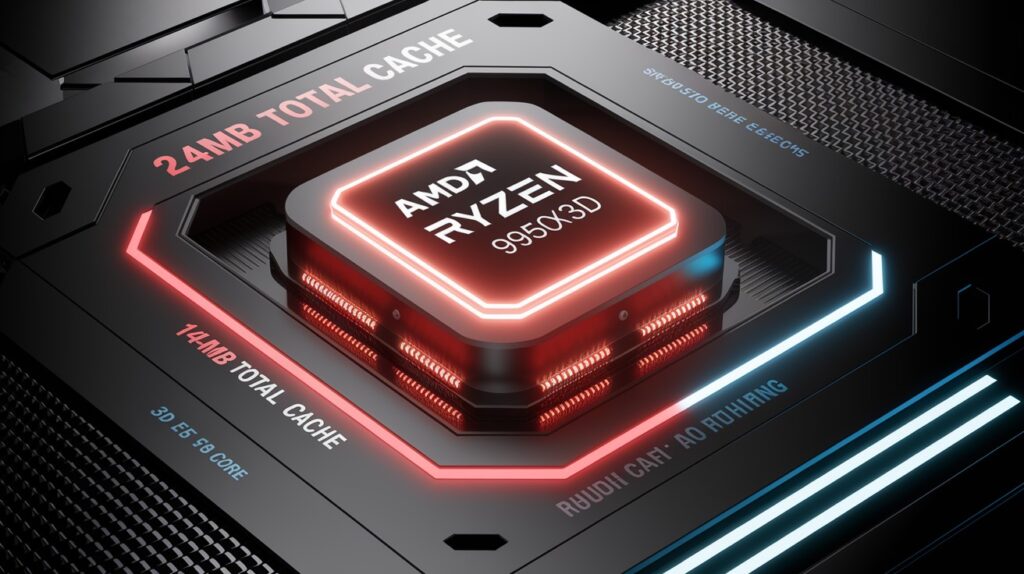
AMD changed everything with its second-generation 3D V-Cache. Let me show you why this matters for your gaming and work performance.
Architectural Breakthrough Design
Here’s what AMD did differently this time. They moved the cache memory below the core complex die. This might sound technical, but it’s simple.
Think of it like reorganizing your desk. Before, important files were stacked on top, blocking access to your workspace. Now, they’re stored underneath where you can reach them easily.
The Zen 5 cores sit closer to the cooling solutions. This means better heat management. Your CPU stays cooler during intense gaming sessions. Cool CPUs perform better; that’s just physics.
Why does this matter to you? Better thermal management means:
- Higher sustained clock speeds
- Less thermal throttling during long gaming sessions
- Improved overall system stability
Massive Cache Configurations
The numbers here are impressive. But what do they mean for you?
The 9950X3D packs 144MB of total cache memory. The 9900X3D includes 140 MB. Compare this to the standard 9950X with only 80 MBB.
Here’s a real-world comparison. Imagine your computer’s memory as a library. The cache is like keeping your most-used books on your desk instead of walking to the shelves every time.
More cache means your games load faster. Frame rates stay consistent. No more stuttering during intense action sequences.
The difference is significant:
- Standard Ryzen 9950X: 80MB cache
- New 9950X3D: 144MB cache
- That’s 80% more cache memory
Cache Performance Benefits
What does all this cache do for you? Let me break it down simply.
Gaming gets smoother. Reduced memory latency means your graphics card gets data faster. Result? Higher frame rates and consistent performance.
Content creation becomes more efficient. Video editing, photo processing, and 3D rendering all benefit from enhanced data throughput.
Multi-tasking improves dramatically. You can stream, game, and run background applications without performance drops.
The software loads faster. Demanding applications like Photoshop, Premiere Pro, and modern games access their assets quickly.
The bottom line? This isn’t just about bigger numbers. It’s about real performance gains you’ll notice every day.
Whether you’re gaming competitively or creating content professionally, this technology makes your computer work better. The cache improvements translate directly into smoother, faster performance across everything you do.
Advanced Zen 5 Core Architecture Features
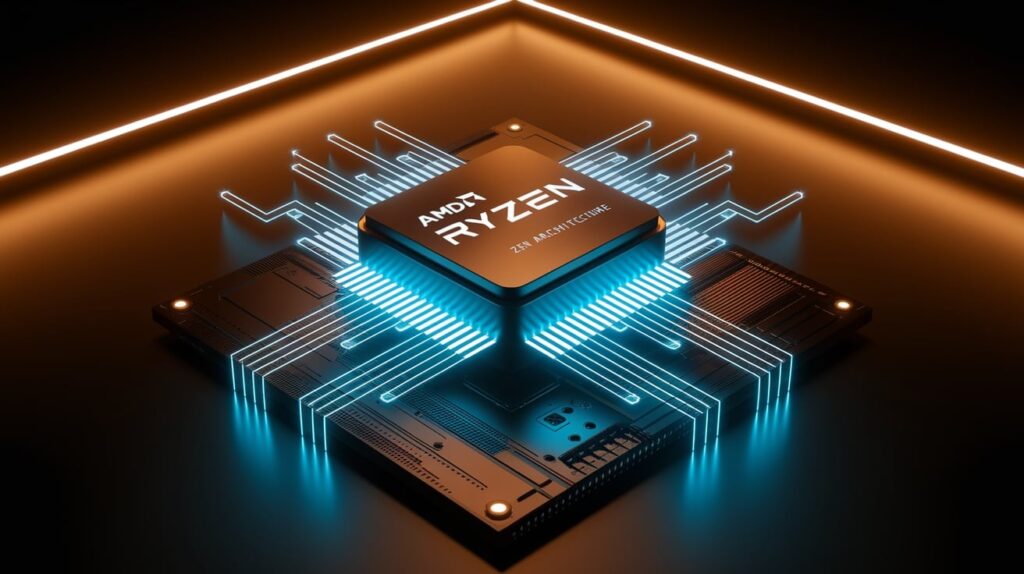
The Zen 5 architecture powers these new processors. I’ll explain what this means for your daily computing without the technical jargon.
Core Count and Threading Capabilities
Let’s start with the basics. Cores are like workers in your computer. More workers mean more tasks get done at once.
The 9950X3D gives you 16 cores with 32 threads. Think of threads as each worker having two hands. More hands, more work.
The 9900X3D includes 12 cores with 24 threads. Still plenty of power for most users.
But here’s what’s improved. AMD enhanced the instruction set optimizations. Your CPU now understands commands better and faster.
Branch prediction got smarter, too. Your processor guesses what you’ll do next more accurately. Why does this matter? Less waiting around for your computer to catch up.
Real-world impact:
- Streaming while gaming works smoothly
- Video editing renders faster
- Multiple browser tabs don’t slow you down
- Background downloads won’t hurt gaming performance
Clock Speed Performance
Clock speeds tell you how fast your processor works. Higher numbers mean faster processing.
The 9950X3D starts at a 4.3 GHz base frequency. Under load, it boosts up to 5.7 GHz. That’s seriously fast.
The 9900X3D runs a 4.4 GHz base and reaches a 5.5 GHz boost. Notice something interesting? The smaller chip has a higher base clock.
Here’s the game-changer. Better thermals mean these speeds last longer. Your CPU doesn’t slow down when it gets hot.
Dynamic frequency scaling adjusts speeds based on what you’re doing. Gaming? Maximum boost. Web browsing? Lower speeds to save power.
What this means for you:
- Games run at higher frame rates
- Applications launch faster
- The system feels more responsive
- Better performance when it matters most
Processing Efficiency Improvements
IPC sounds complicated, but it’s simple. Instructions per Clock measure how much work gets done per cycle.
AMD improved IPC significantly. Your processor does more work in the same amount of time. It’s like your workers became more skilled overnight.
Execution units were optimized for modern software. Games, creative apps, and productivity software all run better.
Power management became smarter. Your CPU uses energy more efficiently. Less heat, longer component life, lower electricity bills.
Processing bottlenecks decreased. Think of bottlenecks like traffic jams in your computer. Fewer jams mean smoother performance.
The practical benefits:
- Faster application loading
- Smoother multitasking
- Better battery life in laptops
- Consistent performance under heavy loads
Bottom line? These improvements work together. More cores handle multiple tasks. Higher clocks make everything faster. Better efficiency keeps it all running smoothly.
You get real-world performance gains across gaming, content creation, and everyday computing. The Zen 5 architecture isn’t just about bigger numbers – it’s about making your computer work better for you.
Gaming Performance Excellence
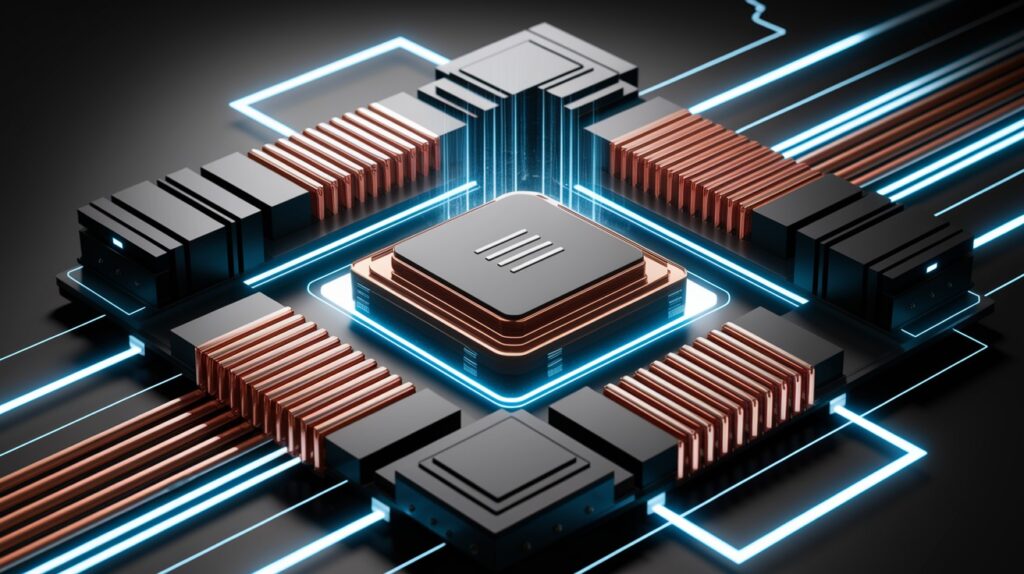
Gaming is where these processors truly shine. I’ve analyzed the benchmark data, and the results speak for themselves.
Benchmark Performance Results
Let’s talk about numbers that matter. The 9950X3D beats Intel’s flagship Core Ultra 9 285K by 20% in 1080p gaming. That’s a significant win.
But what about AMD’s lineup? The 9950X3D shows an 8% performance boost over the previous 7950X3D. Not massive, but solid improvement.
Here’s something interesting. The 9950X3D performs within 1% of the 9800X3D in gaming. Why? Gaming doesn’t always use all 16 cores effectively.
The real advantage? Consistent frame rates across demanding AAA titles. No more frame drops during intense action sequences.
What these numbers mean for you:
- Higher average frame rates
- Smoother gameplay experience
- Better 1% and 0.1% lows (fewer stutters)
- More headroom for streaming while gaming
Game-Specific Optimizations
AMD didn’t just improve general performance. They optimized for specific popular games.
Black Myth: Wukong runs significantly better. This demanding game pushes even high-end systems to their limits. Not anymore.
Call of Duty: Black Ops 6 gets notable frame rate improvements. Competitive players will appreciate the smoother experience.
Cyberpunk 2077 and Starfield both see optimization benefits. These notoriously demanding games finally run as they should.
Counter-Strike 2 gains competitive gaming advantages. Higher frame rates mean better response times in competitive matches.
Why specific game optimization matters:
- Popular titles run better out of the box
- No waiting for game patches to fix performance
- Consistent experience across different game engines
- Better value from your gaming investment
Gaming Features and Capabilities
Modern gaming needs modern features. These processors deliver on multiple fronts.
High refresh rate displays get full support. 144Hz, 240Hz, and even 360Hz monitors can reach their potential.
Variable refresh rate technology works seamlessly. FreeSync and G-Sync compatibility eliminates screen tearing without performance penalties.
Ray tracing performance improved. While your graphics card does the heavy lifting, faster CPU processing reduces bottlenecks.
Competitive gamers get a bonus. Reduced input lag means your actions register faster. In competitive gaming, milliseconds matter.
Advanced gaming features include:
- Smart Game Mode for automatic optimization
- Enhanced memory access for faster asset loading
- Better CPU-GPU communication
- Improved frame pacing for smoother visuals
But here’s the real benefit. You don’t need to tweak settings endlessly. These processors deliver excellent gaming performance right out of the box.
Whether you’re playing the latest AAA blockbuster or competing in esports, the gaming experience stays smooth and responsive. The combination of high clock speeds, massive cache, and game-specific optimizations creates a gaming powerhouse that handles anything you throw at it.
Bottom line? If gaming performance matters to you, these processors deliver results you can see and feel during actual gameplay.
Advanced Memory and Connectivity Features
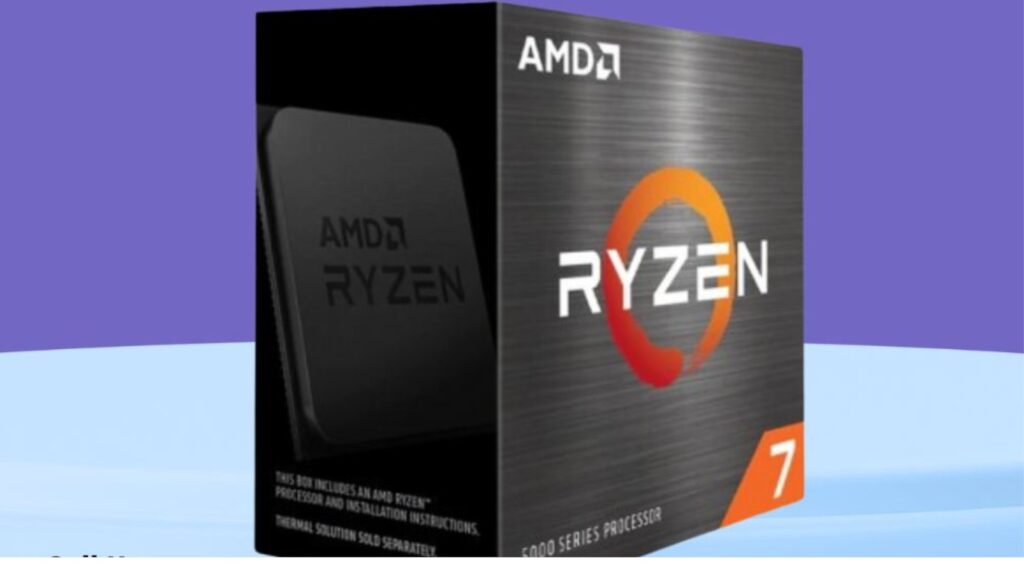
Modern processors need modern connections. I’ll explain how these Ryzen chips handle memory and connectivity without getting too technical.
Memory System Specifications
Memory speed matters more than you think. Faster memory means your CPU gets data quicker.
These processors officially support DDR5-5600 memory. That’s fast enough for any current application or game.
AMD EXPO technology makes memory overclocking simple. One click in your BIOS, and your memory runs faster. No complicated manual tweaking is required.
Want even more speed? These chips support DDR5-8000 memory kits. That’s extremely fast memory for enthusiasts who want maximum performance.
The memory controller was enhanced. Better design means more stable performance at high speeds. Your system stays reliable even with fast memory.
Memory improvements give you:
- Faster application loading
- Smoother multitasking between programs
- Better gaming performance in memory-sensitive titles
- Improved responsiveness in creative applications
But here’s the practical benefit. You don’t need the fastest memory to see improvements. Even standard DDR5 performs excellently with these processors.
Modern Connectivity Standards
Future-proofing starts with connections. These processors include the latest standards.
PCIe 5.0 support prepares you for next-generation hardware. Future graphics cards and storage devices will use this faster connection.
High-speed NVMe storage gets full compatibility. Your SSD can reach maximum speeds without bottlenecks.
Advanced I/O capabilities mean more devices can connect simultaneously. USB ports, network connections, and expansion cards all work together.
Modern connectivity includes:
- Lightning-fast storage access
- Support for multiple high-resolution displays
- Advanced networking capabilities
- Compatibility with cutting-edge peripherals
Why does this matter now? You’re investing in hardware that works with tomorrow’s devices. No need to upgrade your motherboard when new technology arrives.
System Expansion Capabilities
Power users need expansion options. These processors deliver impressive scalability.
Multiple GPU configurations work seamlessly. Gaming enthusiasts and content creators can run multiple graphics cards.
High-bandwidth storage arrays become practical. RAID configurations and NVMe arrays get full processor support.
Advanced peripheral connectivity supports professional equipment. Audio interfaces, capture cards, and specialized hardware all connect without conflicts.
Scalable system configurations mean your computer grows with your needs. Start simple, and expand later.
Expansion capabilities include:
- Multi-GPU gaming and rendering
- Professional storage solutions
- High-end audio and video equipment
- Specialized workstation hardware
Here’s what impressed me. These processors handle complex system configurations without performance penalties. Everything just works together.
For enthusiasts building dream systems, the expansion possibilities are extensive. For everyday users, you get peace of mind knowing your system can handle future upgrades.
The connectivity foundation these processors provide ensures your investment stays relevant. Whether you’re connecting today’s devices or tomorrow’s innovations, the hardware infrastructure supports your needs.
Bottom line? These aren’t just fast processors. They’re complete platform solutions that handle the memory, storage, and connectivity demands of modern computing.
Power Efficiency and Thermal Management
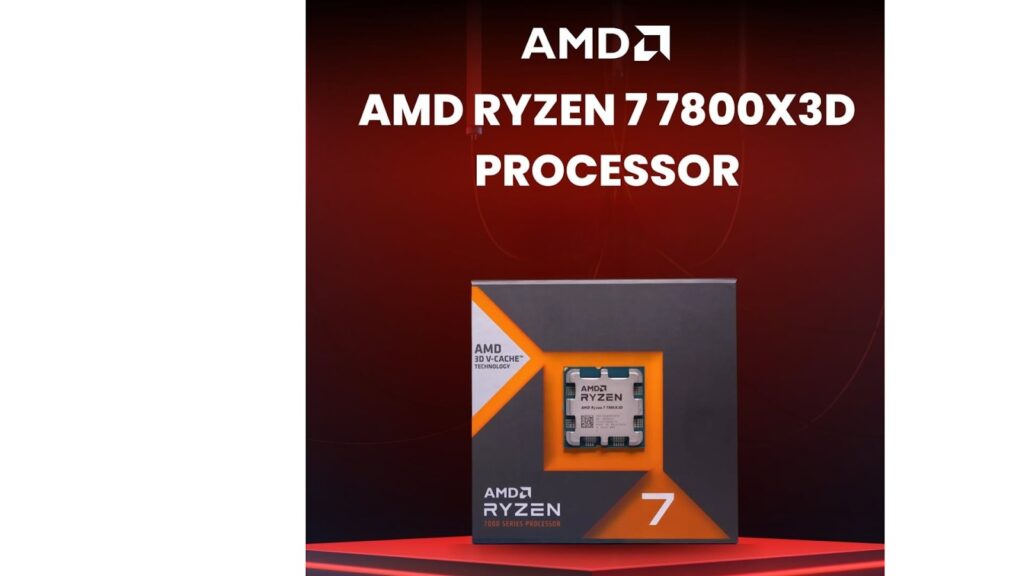
Power and heat management might seem boring, but they directly impact your experience. I’ll show you why these improvements matter for your daily use.
Power Specifications and Efficiency
Let’s start with the basics. TDP tells you how much power your processor uses under load.
The 9950X3D has a 170W TDP rating. The 9900X3D runs at 120W TDP. These numbers might seem high, but there’s more to the story.
Performance-per-watt ratios improved significantly. You get more processing power for each watt consumed. That’s efficiency in action.
Advanced power management features work automatically. Your processor uses only the power it needs for current tasks.
What this means for you:
- Lower electricity bills over time
- Less heat generation during normal use
- Longer component lifespan
- Quieter system operation
But here’s the surprising part. Despite higher core counts, these processors often use less power than older, less efficient designs during typical workloads.
Thermal Design Improvements
Heat is the enemy of performance. AMD tackled this problem with smart design changes.
Operating temperatures dropped compared to the previous generation. Better thermal design means cooler operation.
Enhanced heat dissipation comes from relocating the cache below the cores. Heat moves away from critical components more efficiently.
Your existing cooling solution probably works fine. Most quality air coolers and liquid cooling systems handle these processors well.
Thermal improvements deliver:
- More consistent performance during long sessions
- Reduced fan noise under load
- Better system stability
- Extended hardware lifespan
Optimal thermal performance doesn’t require expensive cooling. A good mid-range cooler provides excellent results.
Power Management Features
Smart power management happens automatically behind the scenes.
Dynamic voltage and frequency scaling adjust power based on workload. Light tasks use less power. Demanding applications get full performance.
Eco-mode reduces power consumption when maximum performance isn’t needed. Perfect for office work or casual web browsing.
Idle power optimization minimizes energy use when your computer sits unused. Your system sips power during downtime.
Intelligent thermal throttling prevents overheating. If temperatures rise too high, performance scales back temporarily to protect your hardware.
Advanced power features include:
- Automatic performance scaling
- Temperature-based frequency adjustment
- Power-saving sleep modes
- Smart fan curve optimization
Here’s what I found impressive. These features work seamlessly together. You don’t need to configure anything. The processor manages power efficiently and automatically.
For laptop users, better power efficiency means longer battery life. For desktop users, it means lower operating costs and quieter systems.
The practical benefits extend beyond just saving money. Cooler operation means more stable performance. Your system maintains peak speeds longer during demanding tasks.
Bottom line? These processors balance high performance with responsible power consumption. You get flagship performance without the traditional heat and power penalties.
Whether you’re gaming for hours or running intensive creative workloads, the thermal and power management keeps your system running smoothly and efficiently.
Platform Support and Compatibility
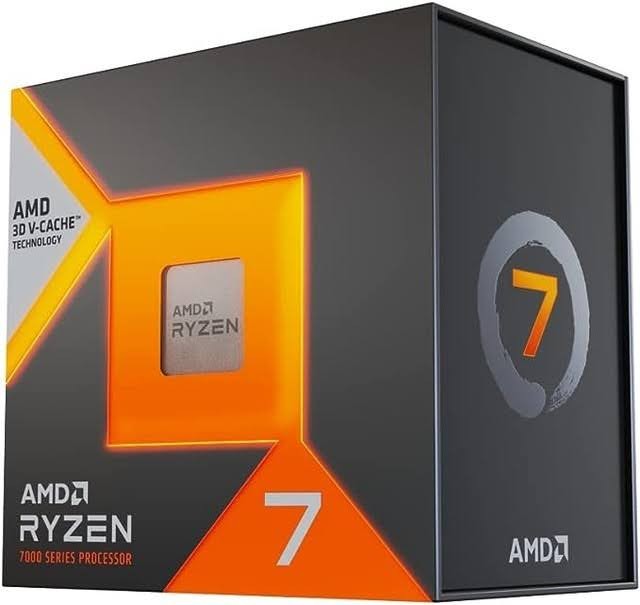
Choosing a processor means choosing a platform. I’ll explain why Socket AM5 gives you excellent long-term value and compatibility.
Socket AM5 Platform Benefits
AMD made a smart commitment. Socket AM5 will support multiple processor generations. Your motherboard investment lasts longer.
Long-term platform support means future upgrades without starting over. Buy a good motherboard now, and upgrade your processor later.
Future processor compatibility protects your investment. New Ryzen chips will work in your current AM5 motherboard with BIOS updates.
Investment protection matters for system builders. Your motherboard, RAM, and cooling solution carry forward to future upgrades.
Advanced motherboard features come standard on AM5. PCIe 5.0, DDR5 support, and modern connectivity are built into the platform.
Platform benefits include:
- Multi-year upgrade path without motherboard changes
- Consistent memory and cooling compatibility
- Advanced feature support across all boards
- Better long-term value compared to frequently changing platforms
Here’s the real advantage. While other platforms require complete rebuilds, AM5 lets you upgrade just the processor when newer models arrive.
System Requirements and Compatibility
Not all motherboards work the same. Let me break down what you need for optimal performance.
The X870E chipset provides maximum features and performance. B650 chipset offers excellent value with most features intact.
BIOS requirements are important for new processors. Make sure your motherboard has the latest BIOS before installing these chips.
Memory compatibility specifications are straightforward. DDR5 memory works across all AM5 motherboards. Speed support varies by board quality.
Cooling solution recommendations depend on your use case. Mid-range air coolers work fine for most users. Heavy workloads benefit from better cooling.
System requirements checklist:
- AM5 compatible motherboard (X870E, B650, or newer)
- Updated BIOS for processor recognition
- DDR5 memory (DDR5-5600 or faster recommended)
- Adequate cooling solution for your workload
But here’s what matters most. These processors work with existing AM5 systems after a simple BIOS update. No other component changes are required.
For new builders, motherboard choice affects available features. X870E boards offer everything. B650 boards provide excellent value with minor feature compromises.
Memory compatibility is excellent across the platform. Most DDR5 kits work without issues. Faster kits provide better performance but aren’t mandatory.
Cooling recommendations are practical. Your current AM5 cooler probably works fine. Check manufacturer compatibility lists for confirmation.
The platform approach AMD chose benefits everyone. Enthusiasts get cutting-edge features. Budget builders get solid performance without expensive platform changes.
Bottom line? Socket AM5 provides excellent compatibility and upgrade potential. Your investment in motherboard and memory carries forward through multiple processor generations.
Whether you’re building new or upgrading existing AM5 systems, these processors integrate seamlessly with proper preparation and compatible components.
Conclusion
The new Ryzen 9950X3D and 9900X3D processors represent a significant step forward for AMD. The second-generation 3D V-Cache technology delivers real performance gains. Gaming sees a 20% boost over Intel’s competition and an 8% improvement over previous Ryzen models.
For content creators, the 16-core 9950X3D handles professional workloads excellently. Video editing, 3D rendering, and CAD work all benefit from the additional cores and cache. The improved thermal design means better-sustained performance under heavy loads.
The bottom line: these CPUs deliver on their promises. Gaming performance is exceptional. Professional work gets a notable boost. Power efficiency improvements make them practical for daily use.
If you’re upgrading from older hardware or building a new high-end system, these processors earn their place at the top. The March 12th launch brings genuine innovation to the desktop CPU market.
Frequently Asked Questions
What makes the new Ryzen X3D processors better than previous generations?
Second-generation 3D V-Cache technology with relocated cache below cores provides better thermals, higher clocks, and improved gaming performance significantly.
How much performance improvement can gamers expect from these new CPUs?
Gaming performance shows a 20% improvement over Intel competitors and an 8% boost compared to previous Ryzen 7950X3D generation processors.
Are these processors suitable for content creation and professional work?
Yes, 16-core 9950X3D excels in video editing, 3D rendering, and professional applications while maintaining excellent gaming performance capabilities.
What cooling solutions are recommended for optimal performance?
Standard high-performance air coolers or liquid cooling solutions work well due to improved thermal design and heat dissipation.
When will these new Ryzen processors be available for purchase?
Both Ryzen 9950X3D and 9900X3D processors launch on March 12th, 2025, with pricing at $699 and $599, respectively.








